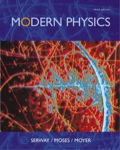
(a)
The lowest energy of the system in which electrons occupy respective state.
(a)
Answer to Problem 17P
The lowest energy of the system in which electrons occupy respective state is
Explanation of Solution
The particle placed in a cubical box is a well-known model in the field of
The particle in a box is a completely hypothetical model which illustrates the basic difference between the classical and quantum models. According to
Write the expression for the energy of the particle in cubical box.
Here,
According to Pauli Exclusion Principle, no more than two fermions can occupy same state. The electros are also fermions and are identical due to which any two electrons can occupy any state.
The electrons will, first, occupy ground state and then they will occupy further states with two electrons filled in each state.
The minimum energy of the system is the sum of energies of electrons present in ground state and other states. The electrons can also occupy the degenerate energy state due to which there can be three possible combinations, of respective
The energy of the electrons presents in the states
Write the expression for the minimum energy of the system of 8 electrons.
Simplify the above expression.
Here,
Conclusion:
Substitute
Substitute
Substitute
Thus, the lowest energy of the system in which electrons occupy respective state is
(b)
The lowest energy of the system of particles which have same mass as electrons but do not obey exclusion principle.
(b)
Answer to Problem 17P
The lowest energy of the system of particles which have same mass as electrons but do not obey exclusion principle is
Explanation of Solution
Since, the particles do not obey exclusion principle. Therefore all the particles can occupy same state that is ground state.
Write the expression for the minimum energy.
Here,
Conclusion:
Substitute
Substitute
Thus, the lowest energy of the system of particles which have same mass as electrons but do not obey exclusion principle is
Want to see more full solutions like this?
Chapter 9 Solutions
EBK MODERN PHYSICS
- For what value of the principal quantum number n would the effective radius, as shown in a probability density dot plot for the hydrogen atom, be 1.0 mm? Assume that l has its maximum value of n - 1.arrow_forwardFor a 3d electron in an external magnetic field of 2.50 × 10-3 T, find (a) the current associated with the orbital angular momentum, and (b) the maximum torque.arrow_forwardConsider hydrogen in the ground state, 100 . (a) Use the derivative to determine the radial position for which the probability density, P(r), is a maximum. (b) Use the integral concept to determine the average radial position. (This is called the expectation value of the electrons radial position.) Express your answers into terms of the Bohr radius, a0. Hint: The expectation value is the just average value, (c) Why are these values different?arrow_forward
- For the hydrogen atom in its ground state, calculate (a) the probability density c2(r) and (b) the radial probability density P(r) for r = a, where a is the Bohr radius.arrow_forwardConsider a quantum mechanical ideal harmonic oscillator having a zero point energy of 1.4*10^-20J. how much energy could be released if the oscillator makes a transition from n=4 to n=2 states? a)0.69*10^19J b)2.88*10^-20J c)5.76*10^20J d)none are correctarrow_forward
 Modern PhysicsPhysicsISBN:9781111794378Author:Raymond A. Serway, Clement J. Moses, Curt A. MoyerPublisher:Cengage Learning
Modern PhysicsPhysicsISBN:9781111794378Author:Raymond A. Serway, Clement J. Moses, Curt A. MoyerPublisher:Cengage Learning Principles of Physics: A Calculus-Based TextPhysicsISBN:9781133104261Author:Raymond A. Serway, John W. JewettPublisher:Cengage Learning
Principles of Physics: A Calculus-Based TextPhysicsISBN:9781133104261Author:Raymond A. Serway, John W. JewettPublisher:Cengage Learning University Physics Volume 3PhysicsISBN:9781938168185Author:William Moebs, Jeff SannyPublisher:OpenStax
University Physics Volume 3PhysicsISBN:9781938168185Author:William Moebs, Jeff SannyPublisher:OpenStax Physics for Scientists and Engineers with Modern ...PhysicsISBN:9781337553292Author:Raymond A. Serway, John W. JewettPublisher:Cengage Learning
Physics for Scientists and Engineers with Modern ...PhysicsISBN:9781337553292Author:Raymond A. Serway, John W. JewettPublisher:Cengage Learning



